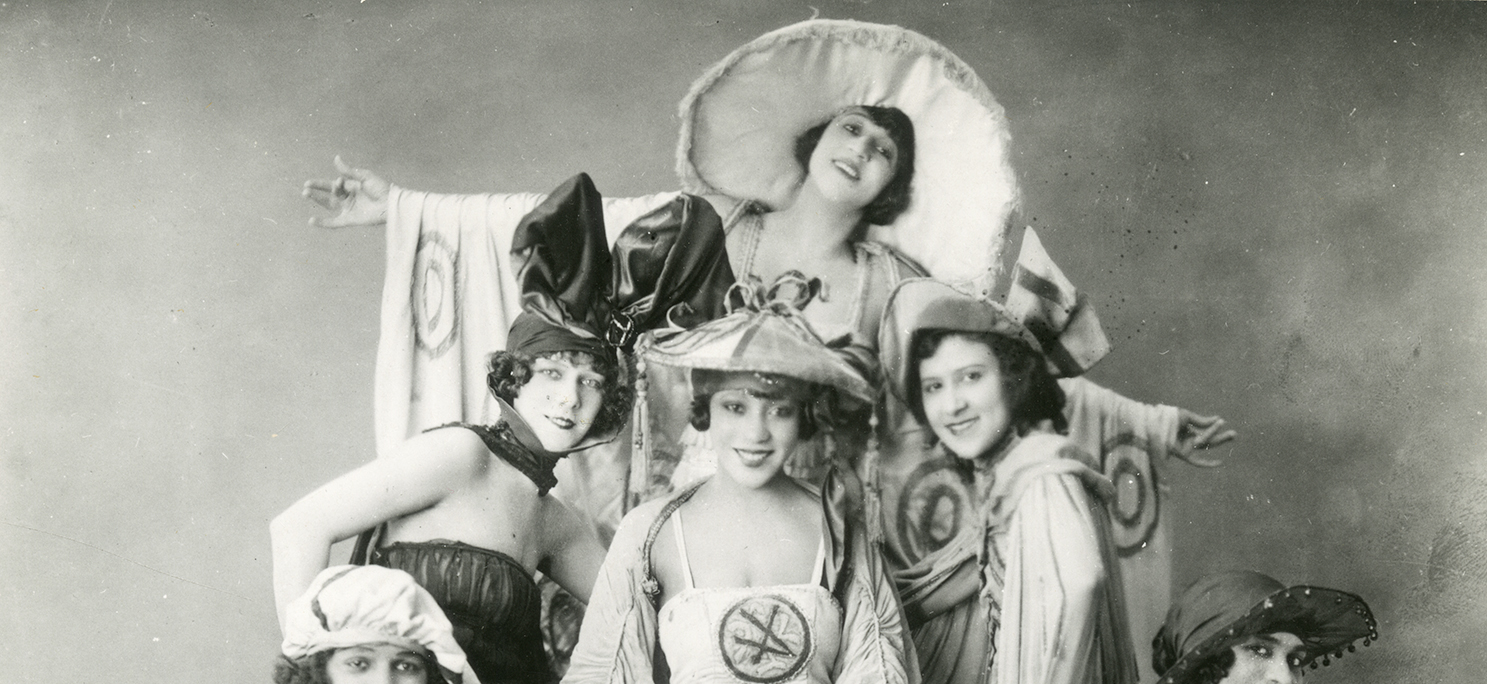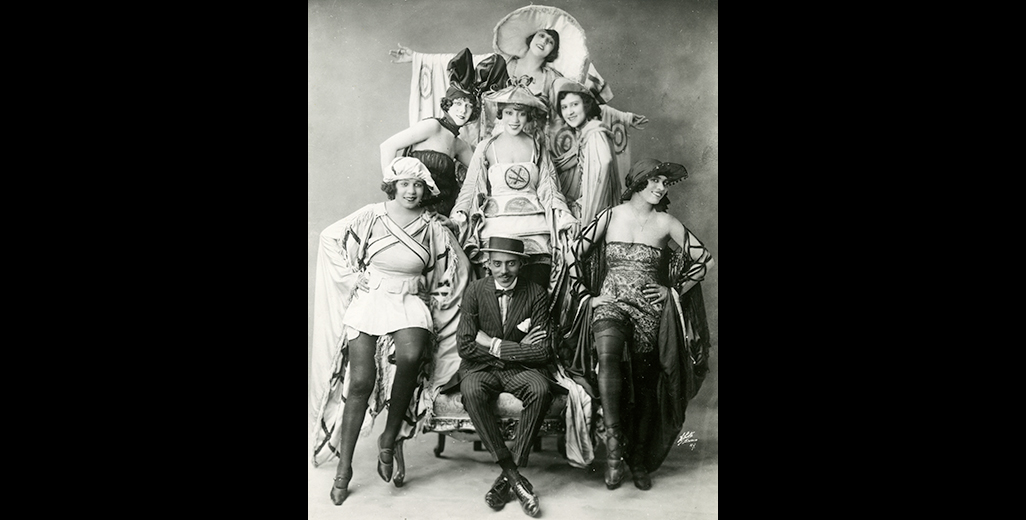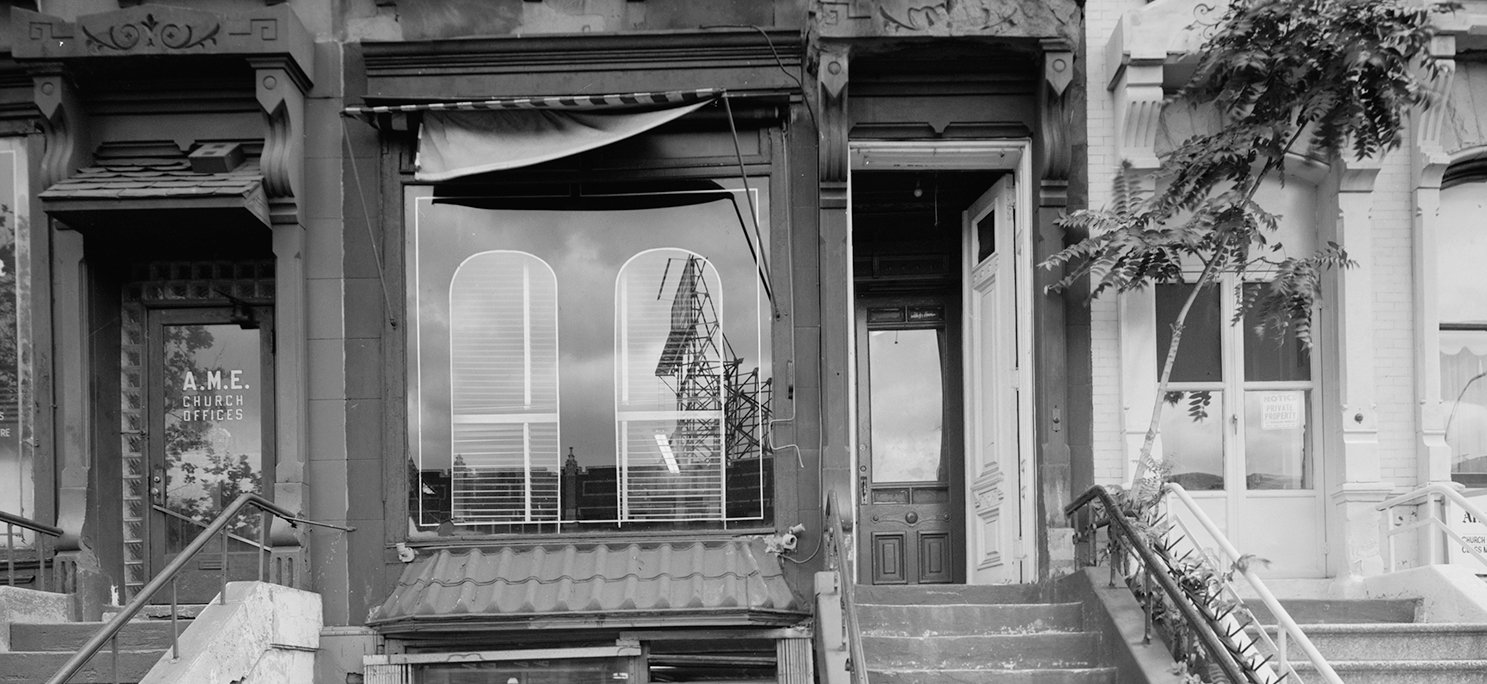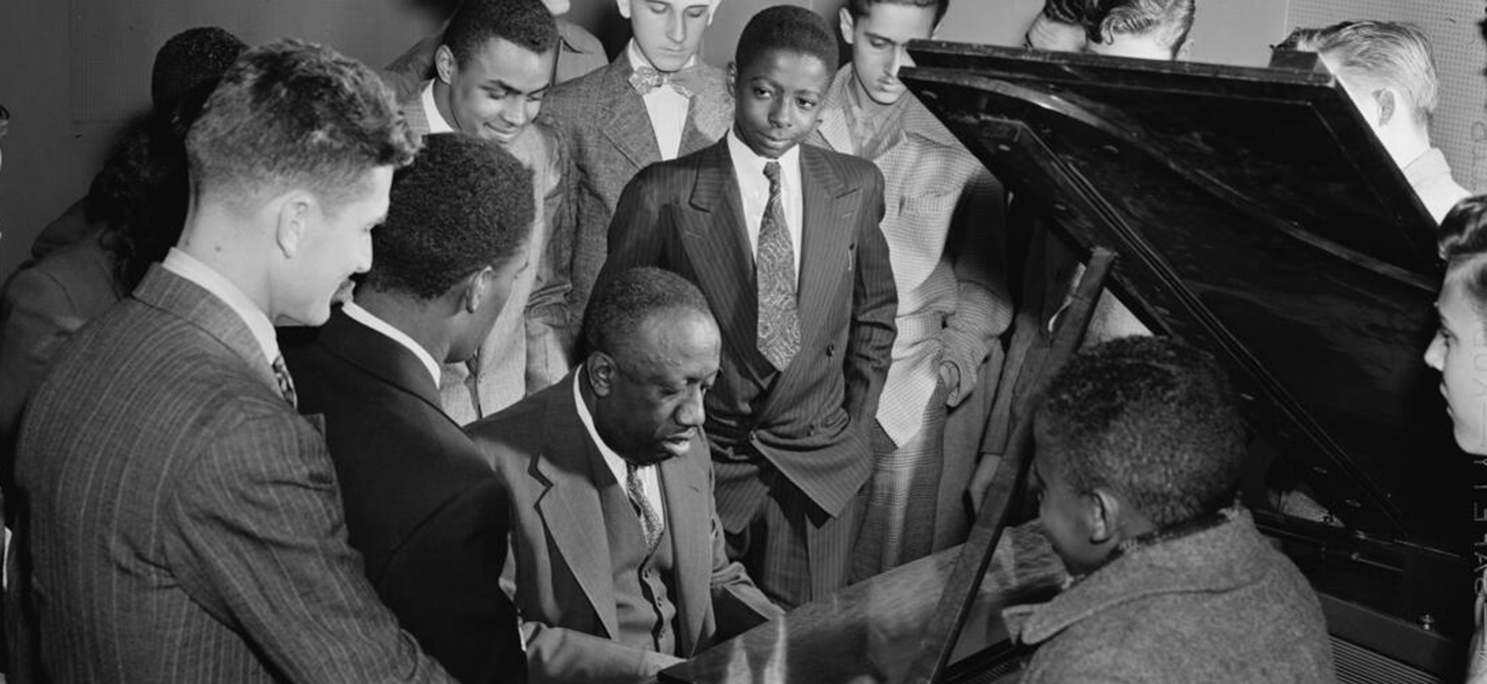Cast members from the musical "Shuffle Along," ca. 1921
Photo: New York Public Library
Shuffle Along: The Musical That Sparked a Black Renaissance
Shuffle Along: The Musical That Sparked a Black Renaissance
September 18, 2023
by Caseen Gaines, Author and Educator
Throughout the early portion of the 1920s, decades before the Lincoln Center complex became Manhattan’s premiere artistic hub, West 63th Street was home to Shuffle Along, one of the most groundbreaking and profitable theatrical productions to have hit New York to date. Eight times a week, the area just east of San Juan Hill was packed with both Black and white theatergoers, including celebrities and political figures, who were all eager to see the groundbreaking two-act musical comedy at the 63rd Street Music Hall, which was written and performed entirely by Black Americans. Its score was a clever amalgamation of jazz and ragtime, built upon a foundation of the traditional European operetta fare that was expected, and until Shuffle Along’s debut, was the most popular style of music on the Broadway stage. Immediately upon its opening night of May 23, 1921, the creative brainchild of musicians Noble Sissle and Eubie Blake (who wrote the lyrics and composed the music, respectively) and book writers and co-stars Flournoy Miller and Aubrey Lyles forever changed the look and sound of American musical theater, as well as the neighboring San Juan Hill neighborhood.
Although the musical opened with approximately $21,000 in debt, equivalent to nearly $350,000 when adjusting for inflation in 2023, and played over a dozen blocks beyond the heart of the theater district, Shuffle Along became an unlikely breakout hit of 1921. Even though audiences were required to travel just outside of San Juan Hill for the theatrical talk of the city, Shuffle Along’s ticket pricing, which reached as high as $3.00, qualified it as a bona fide Broadway show. The musical was such a hit that, shortly after its opening, New York City permanently changed the traffic patterns throughout San Juan Hill and its adjacent neighborhoods to accommodate the unexpected influx of cars and pedestrians in the vicinity of the theater.
Part of the show’s success was due to the ingenuity and business acumen of its creative team. While it was, and remains, standard for Broadway musicals to have a Wednesday matinee, Shuffle Along’s producers replaced their afternoon show with a midnight performance to accommodate the white performing artists who wanted to see the musical that everyone was talking about. The result was sold out performances with mixed race audiences, scheduled at a time when the musical was literally the only ticket in the city. “White show people spread the word,” Noble Sissle said, with Flournoy Miller adding, “Then Negroes came to see the celebrities.”
Among the celebrities who could be spotted at Shuffle Along on any given night were vaudeville singer and actor Al Jolson, who frequently bought out the house and gave away tickets to his famous friends, as well as a celebrated composer who likely derived inspiration from the show’s use of syncopated rhythm in his own works. “Irving Berlin used to sit behind me,” Eubie Blake, who also conducted the orchestra, recalled. “He’d say, ‘Tell Mr. Sissle I take my hat off to those lyrics.” Among the show folk, well-known politicians were known to frequent the musical. The show was a favorite of New York City Board of Alderman president Fiorello La Guardia, who saw the musical at least three times.
But Shuffle Along’s appeal wasn’t limited to whites with wealth, nor Black audiences interested in seeing whites with wealth. While nearly ninety percent of the audience was made up of white theatergoers, the show’s unprecedented success—its Broadway run ultimately lasted 504 performances and spawned several touring companies that traveled throughout North America, including the Deep South—was due in part to its favor among African Americans. The Black press was particularly robust during the 1920s, and many papers like the New York Amsterdam News, which originated in San Juan Hill, were strong champions of the show. The musical was also written about favorably by leaders like Claude McKay and W. E. B. Du Bois, the latter of whom described Shuffle Along in 1922 as “one of the cleanest, tunefulest, and cleverest variety shows ever given.”
Twenty-year-old Langston Hughes was among the everyday Black citizens who heard the siren call. He had heard about the musical when he was living with his father in Mexico, years before he became one of New York’s best known writers of the 1920s, and was eager to see what was being celebrated as the pinnacle of Black entertainment. Although his father wanted him to study abroad in Switzerland, Hughes chose to attend Columbia University solely because of the must-see musical. “Shuffle Along had just burst into being, and I wanted to hear Florence Mills sing,” he recalled, adding that he “sat up in the gallery night after night at Shuffle Along.”
Hughes’ response to learning about Shuffle Along was standard, even before the show was a success. When its creators held auditions at the Cort Theatre in Times Square before its opening, Black artists flocked to the city from around the country, even though the musical’s success was anything but a sure thing. “There were a lot of good Negro vaudeville acts to pick from,” Noble Sissle recalled. “The players knew that they had little future in vaudeville because of their race and when we told them we had no money, but would not take them farther than walking distance from New York, they agreed to gamble with us.”
It’s important to note that while Shuffle Along was an all-Black production, it was also a watershed moment for the city’s Puerto Rican population, as several musicians who played in the show’s orchestra were skilled zarzuela musicians. Having Boricuas—Puerto Ricans living in mainland America—in the pit was a win for everyone; Eubie Blake had incredibly gifted musicians who could add their cultural flair to his score and the Puerto Rican musicians, who were prohibited from playing in white orchestras, were granted an opportunity to showcase their talents — and earn a decent living too.
While the musical ultimately was a springboard for star performers like Lottie Gee, Roger Matthews, and Gertrude Saunders—as well as notable chorines like Ravella Hughes, who would go on to choreograph “Charleston” for the 1923 Broadway musical Runnin’ Wild, popularizing the dance—there were many talented Black artists, such as twenty-six-year-old Alberta Hunter, who would go on to have a seven-decades-long celebrated jazz career, who failed to make the final cut. One young performer who failed to make the show during her first and second auditions, a teenage Josephine Baker, managed to find her way into one of the touring companies before being invited to join the main company.
But even those who weren’t as fortunate as Baker were still able to make a living and leave their mark on the city. It was common for those performers to remain in New York, picking up gigs in and around Harlem and San Juan Hill. This, when coupled with the success of Shuffle Along and the subsequent resurgence of all-Black musicals it inspired, led to a cultural revolution that began in New York and spread throughout the world.
“The 1920s were the years of Manhattan’s Black Renaissance. It began with Shuffle Along…a honey of a show,” Langston Hughes wrote in his 1940 memoir The Big Sea. “Swift, bright, funny, rollicking, and gay, with a dozen danceable, singable tunes…Everybody was in the audience—including me. People came back to see it innumerable times. It was always packed…It gave just the proper push—a pre-Charleston kick—to that Negro vogue of the ’20s, that spread to books, African sculpture, music, and dancing.”
The widespread success of an all-Black Broadway musical was just as unlikely in 1921 as it is today. At the time of the show’s opening, Manhattan was still recovering from the pandemic of 1919, which killed over two hundred thousand New Yorkers, nearly a third of the total lives lost in the nation. Many Broadway houses were still shuttered and, due to a host of factors, the local economy was decimated. The state was hit particularly hard by the ratification of the Eighteenth Amendment to the United States Constitution, which prohibited the manufacture, sale, and transportation of alcohol. The new laws went into effect in January 1920, creating an underground market for bootleg spirits and depriving the state of a steady revenue stream via the legal sale of liquor.
Beyond what was happening in Manhattan, there were other national considerations. The show was staged in the aftermath of the greatest period of racialized violence in this country since the Civil War. W. E. B. Du Bois famously encouraged African Americans to put aside their feelings about the country’s continued legacy of race discrimination and fight in the first World War, in the hopes that it would endear Blacks to their greater citizenry, yet many white Americans did not look favorably upon Black veterans once they returned home. Lynchings were on the rise, resulting in what became known as the Red Summer of 1919, where a significant number of Black veterans who failed to be sufficiently submissive lost their lives at the hands of whites who wanted to maintain the status quo in terms of racial power dynamics.
With all of these headwinds, how was it that Shuffle Along became the first all-Black musical comedy to succeed in Manhattan in over a decade? Noble Sissle had a theory. “Very few people of the Broadway theatrical managerial staff believed in us, and there were few among our own group who felt we had a chance,” he wrote in an unpublished memoir. “However, we felt we had a message—we felt that the gloom and depression as an aftermath of the war had left the country hungry for laughter. That was so expressed in our music and rhythm.”
It may be impossible to know whether people flocked to Shuffle Along for escapism as Sissle suggests, but by most accounts, he is correct in noting that music is what brought patrons to 63rd Street in droves. For the first time, the sounds of the city’s Harlem and San Juan Hill neighborhoods entered the Great American Songbook, with one standout number from the musical, “I’m Just Wild About Harry,” remaining a well-known and oft-covered jazz standard to this day. In 1948, it was famously used as part of Harry Truman’s winning Presidential campaign.
Importantly, Shuffle Along’s creators triumphed by embracing their cultural roots and, in a move that may have been considered ill-advised, comically commenting on the topical issues. In addition to the music, Miller and Lyles’ book was revolutionary as well. Shuffle Along was a musical adaptation of their 1906 play The Mayor of Dixie, which had a successful run at Chicago’s Pekin Theater, the world’s first Black-owned playhouse. The plot centered on a three- way mayoral race in the fictional municipality of Jimtown, wherein two of the candidates—Steve Jenkins and Sam Peck, played by Miller and Lyles, respectively—co-owned a grocery store. The business partners were both duplicitous and unscrupulous, and knew the other person possessed the same qualities, so they each hired a private detective to ensure the cash register wasn’t being drawn upon to finance the other person’s campaign. However, in true comedic fashion, they each end up hiring the same person. The third candidate, Harry Walton, is virtuous and has entered politics for the right reasons, so of course, he does not win. In the end, it’s revealed that Jenkins, the winner of the vote, had committed campaign fraud, as did Peck, and Walton is elected mayor by default.
Nearly 45 years before Lyndon B. Johnson signed the Voting Rights Act and less than a year after women, mostly white women, were granted the franchise, a political satire written and performed by Blacks could have been controversial, but based on the strength of Miller and Lyles’ writing and acting, it was received as lighthearted entertainment.
Another example of the show’s timeliness can be found in the character arc of Ruth Little, who was played by Gertrude Saunders before she was replaced by Florence Mills. Early in the show, Ruth is asked when she is going to settle down and get married. She responds that she wants “none of that wedding stuff” before going into “I’m Just Simply Full of Jazz,” a show-stopping number with lyrics that reflected the sentiments, and resentments, of the growing flapper movement: Everybody thinks I’m crazy / They think I’ve gone plum-mad…Though I seem a little hazy / I ain’t crazy / I’m just simply full of jazz.
Shuffle Along may not be the best-remembered musical to have come out of the 1920s—that distinction likely belongs to 1927’s Showboat—but it was certainly the most influential. The musical helped develop the art scene in the vicinity of San Juan Hill, and was a watershed moment for racial representation on stage. In fact, for all of the show’s accomplishments in regards to theater, its creators were proudest of the musical’s abilities to change hearts, minds, and attitudes toward Black Americans through entertainment.
“My partner and I want to be evangelists,” Noble Sissle said in 1924. “We want to do something for the Negro race, to which we belong. And if we compel white audiences to listen to us; if we entertain them and if out of ten thousand persons who see and hear us, one hundred think a little better of the Colored man than in the past, then we have done something that’s better than salary. In fact, that’s what we want to do. It is our biggest aim.”
References
Bell, Archie. “Jazz Most Popular Music of the Day,” Chicago Defender, May 31, 1924.
Du Bois, W. E. B. “We Shuffle Along,” The Crisis, September 1922.
“Dramatic Story of Success of ‘Shuffle Along’ Told by Noble Sissle, Eubie Blake: Present Stars of Phenomenal All-Color Show Tell of Trials Before Play ‘Went Over’ From Detroit Time Piece,” Pittsburgh Courier, September 22, 1923.
Gaines, Caseen. When Broadway Was Black: The Triumphant Story of the All-Black Musical That Changed the World. Naperville, IL: Sourcebooks, 2023.
Glasser, Ruth. My Music Is My Flag: Puerto Rican Musicians and Their New York Communities, 1917–1940. Berkeley: University of California Press, 2000.
Glenn Giffen, “Man on the Eighty-Eight Is Just That,” Denver Post, May 6, 1971.
Hughes, Langston. The Big Sea: An Autobiography. New York: Farrar, Straus and Giroux, 2015
Sissle, Noble Lee. Autobiography of Noble Sissle, unpublished manuscript. Helen Armstead-Johnson Miscellaneous Theater Collections, Sc MG 599, Schomburg Center for Research in Black Culture.
Stearns, Marshall, and Jean Stearns. Jazz Dance: The Story of American Vernacular Dance. New York: Da Capo, 1994.









